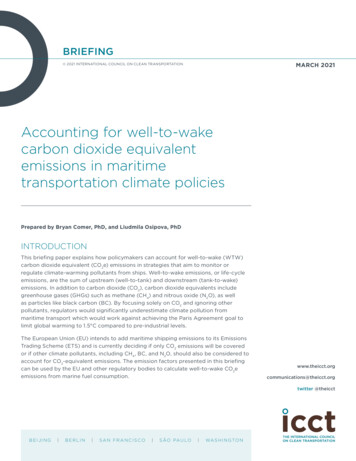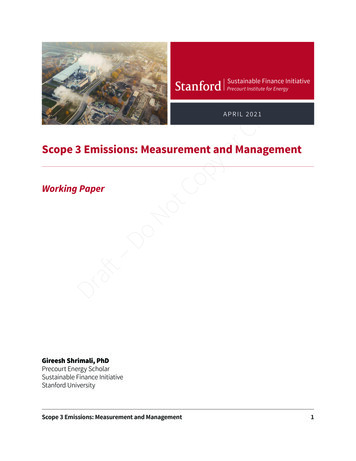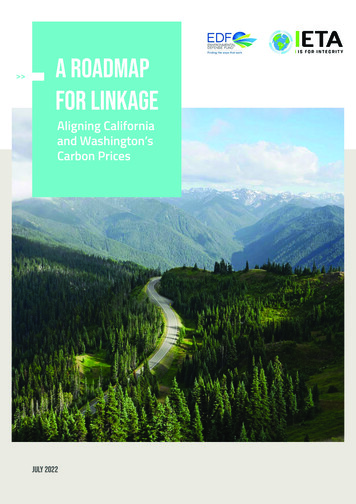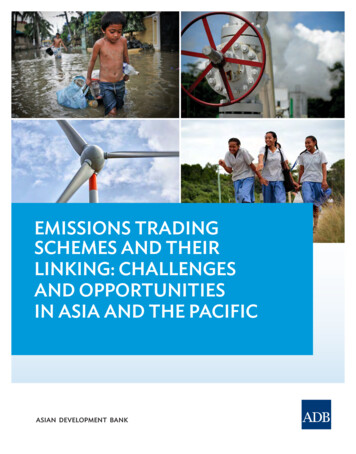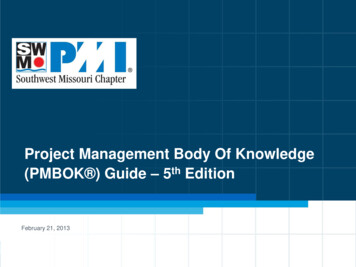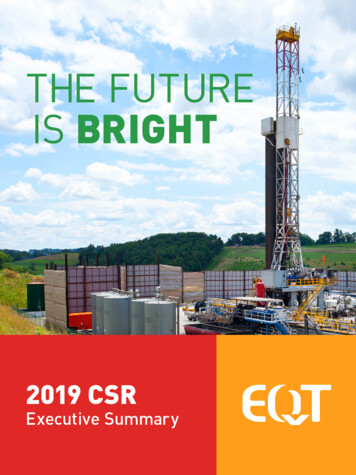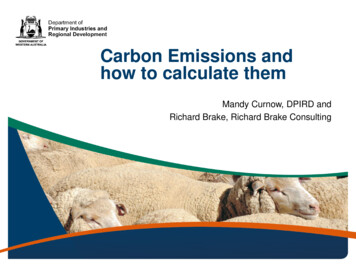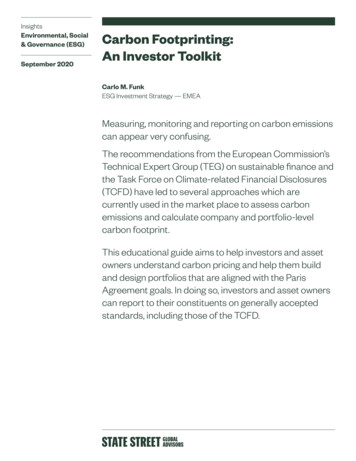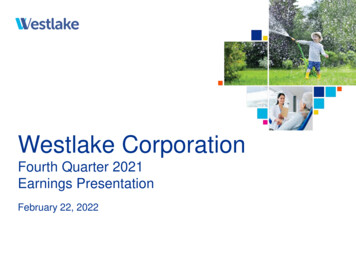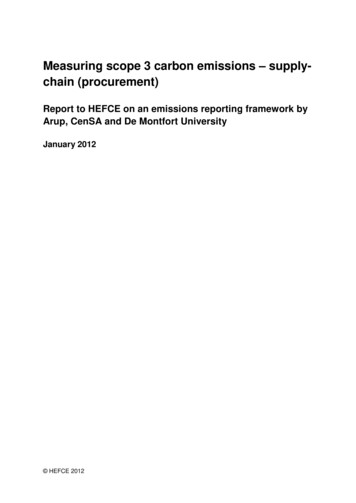
Transcription
Measuring scope 3 carbon emissions – supplychain (procurement)Report to HEFCE on an emissions reporting framework byArup, CenSA and De Montfort UniversityJanuary 2012 HEFCE 2012
Table of contentsExecutive Summary . 21.Introduction . 42.Background. 63.Project requirements . 94.Supply-chain (procurement) emissions reporting tool: review of options . 115.Development of the supply-chain (procurement) emissions reporting tool . 176.Successful implementation of the reporting tool . 23Annex A. ProcHE and UNSPSC input codes . 25Annex B. Supply-chain (procurement) webinars Q&A . 45Terms and acronyms . 491
Executive Summary1.This report summarises the key steps of the development of a supply-chain(procurement) greenhouse gas (GHG) emissions reporting tool for the use by highereducation institutions (HEIs) from 2012-13, believed to be the first public sectororganisational emissions reporting framework for scope 3 supply-chain(procurement) emissions in the world.2.Although the term ‘procurement emissions’ is widely used as a shorthand forelements of scope 3 emissions it does not accurately describe the purchasing ofgoods and services which generates these emissions. DEFRA guidance on scope 3does not use this term but instead talks about emissions from the supply chain, whichis more accurate. Therefore we have used a description of ‘supply chain(procurement) emissions’ throughout this document and guidance in order to retainaccuracy but also aid understanding.3.The project aim was to ‘develop a reporting framework to measure supply-chain(procurement)-based scope 3 emissions from HEIs in England from 2012-13’.Several systems were reviewed, one based on the Estates Management System(EMS), one based on the Financial Management System (FMS), and the third basedon the Annual Returns Database (ARD) system.4.The option ultimately selected was based on the ARD system. An Excel-based toolhas been developed to be run as follows. It is aligned to the traditional reporting ‘season’: at the end of the financial yearHEIs will submit their spend data to the four purchasing consortia in England:London Universities Purchasing Consortium (LUPC), North East UniversitiesPurchasing Consortium (NEUPC), North West Universities PurchasingConsortium (NWUPC), and Southern Universities Purchasing Consortium(SUPC) The data submitted will need to be in ProcHE or the United Nations StandardProducts and Services Code (UNSPSC) formats. The consortia-held tool will thenmap the expenditure to carbon intensity data to produce output emissions results These results are then produced in output tables and graphs and an emissionsreport is then passed back to the HEIs.5.The final tool has several key benefits including: Harnesses an existing system: by calculating emissions through the ARDprocess, the burden on HEIs is minimised – a key desired outcome from thisprocess Provides incentives to both HEIs and consortia: by only mapping classifiedspend to CO 2 emissions, there is an incentive for HEIs to improve classification.There is also an incentive for the consortia, as by providing useful CO 2 reports2
they will receive better input data. In addition, as coding from HEIs improves, lesstime will be required within consortia to map non-coded dataReduces emissions errors: by performing emissions calculations within theconsortia, the potential user errors are reduced versus 130 HEIs each havingtheir own systemsAllows the review of supply-chain (procurement) emissions among HEIs:due to the central hosting of the tool, there will be a future facility to compareemissions among HEIs of the same type – for example large research or medicalbased institutions. This may provide insights into different patterns of emissionsby different HEI types, and also variances within the same HEI type.3
1. IntroductionProject outline1.1Following the publication in 2010 of the Higher Education Funding Council forEngland (HEFCE) carbon reduction target and strategy for higher education (HE) inEngland 1, HEFCE commissioned Arup, De Montfort University and the Centre forSustainability Accounting (CenSA) to assist in measurement of scope 3 supply-chain(procurement) emissions by higher education institutions (HEIs) in England.1.2Although the term ‘procurement emissions’ is widely used as a shorthand forelements of scope 3 emissions it does not accurately describe the purchasing ofgoods and services which generates these emissions. DEFRA guidance on scope 3does not use this term but instead talks about emissions from the supply chain, whichis more accurate. Therefore we have used a description of ‘supply chain(procurement) emissions’ throughout this document and guidance in order to retainaccuracy but also aid understanding.1.3The brief was to develop a reporting framework for English HEIs’ scope 3 supplychain (procurement) emissions, for use from 2012-13. The project comprised two keydeliverables: A consortia-held reporting tool: an Excel based spreadsheet which calculatesindividual institution supply-chain (procurement) emissions based on receivedexpenditure data. This research report: which shows the process and decisions that were madethat led to the consortia held tool being developed.1.4In addition to the institution level project, a sector-wide baseline study of supply-chain(procurement) emissions was completed in parallel, for 2005-06. This report containsa more detailed treatment of the consumption-based methodology used for both thesector and institution level studies.Report Structure1.51The research study is reported in the sections listed below. Section 2. Background: presents an overview of the policy context andbackground to the scope 3 reporting requirement. Section 3. Supply-chain (procurement) emissions reporting – review ofoptions: three options for reporting supply-chain (procurement) emissions inHEIs are outlined, with a final selection of the preferred candidate. Section 4. Development of the tool: describes the basic structure and format ofthe tool that was developed, and the consultation that was undertaken.HEFCE (2010). Carbon reduction target and strategy for higher education in England, HEFCE available at http://www.hefce.ac.uk.4
1.6Section 5. Successful implementation of the tool: describes how the tool isenvisaged to be hosted and gives guidance to HEIs and consortia.This report also contains the following Annexes: Annex A: ProcHE and UNSPSC input codes Annex B: Supply-chain (procurement) webinars Q&A.Acknowledgements1.7This project has required the cooperation of and input from many organisations in theHE sector. We express our sincere thanks to: All English HEIs that gave permission for us to obtain and use their collatedexpenditure data for the determination of the sector supply-chain (procurement)emissions The four purchasing consortia in England who passed the expenditure data to us:LUPC, NEUPC, NWUPC, SUPC Andy Wojciechowski from NWUPC, who input significant time and effort to helpwith queries and comments related to development of the tool HEFCE The Measuring Scope 3 Carbon Emissions Advisory Group members who arelisted below:ChairTony RichUniversity of Essex;Association of Heads of University Administration;HEFCE’s Sustainable Development Steering GroupMembersSarah GrimesHigher Education Statistics AgencySue HolmesLeeds Metropolitan University;Association of University Directors of Estates (AUDE)Jonathan MillsUniversity of Lancaster;Environmental Association for Universities andColleges (EAUC)Tony OverburyUniversity College LondonTim PryceThe Carbon TrustPaul TomanyENP;NWUPC5
2. BackgroundSupply-chain (procurement) emissions2.1The three categories of HE emissions are shown in Figure 2.1 below.Building energy: Directemissions from HE sectorbuildings and equipment andindirect emissions fromelectricityTravel emissions: From HE sectorstaff and student travelSupply-chain (procurement): Embodied emissions ofthe goods and services consumed by the HE sector,excluding building energy and travelFigure 2.1: HE sector primary emissions categories2.2Guidance exists or is being developed for building energy and travel emissions withinthe Estates Management System (EMS). Therefore this project addresses theprocess for capturing supply-chain (procurement) emissions. An important point tonote is that scope 3 ‘procurement’ emissions do not refer to the act of procurement,but rather the embodied upstream emissions associated with the manufacture anddistribution of a product or service purchased i.e. from the supply chain.Scope 3 emissions2.3As the research brief includes a reference to scope 3 emissions it is useful at thispoint to understand what are scope 1, 2 and 3 emissions. The “Greenhouse GasProtocol” (also known as the GHG Protocol, see http://www.ghgprotocol.org)categorises GHG 2 emissions as being Scope 1, 2 or 3, as defined below and shownin Figure 2.2. Scope 1 emissions: direct GHG emissions occurring from sources owned orcontrolled by the organisation. Examples include vehicle fleet emissions, on-siteemissions from boilers and combined heat and power (CHP) energy generation. Scope 2 emissions: GHG emissions from the off-site generation of gridelectricity used by the organisation. Scope 3 emissions: an optional reporting category for all other indirectemissions, which are a consequence of the organisation’s activities but occurfrom sources not owned or controlled by the organisation. Examples include2Six main GHG gases were included within the 1997 Kyoto Protocol: carbon dioxide (CO2); nitrous oxide (N2O); methane (CH4);hydrofluorocarbons (HFCs); perfluorocarbons (PFCs); and sulphur hexafluoride (SF6). These gases trap heat in the earth’s atmosphere,such that higher GHG levels cause higher temperatures – the so called ‘greenhouse effect’.6
‘upstream’ emissions from the production and transportation of purchased goods,and ‘downstream’ emissions from the use and disposal of the organisation’sproducts and services.Figure 2.2: GHG Protocol classification of emissions 3Environmentally extended input-output (EEIO) analysis2.4The sector level supply-chain (procurement) emissions for HE have been calculatedusing an environmentally extended input-output (EEIO) model. This uses top-downcarbon intensity data combined with a breakdown of bottom-up expenditure data toproduce overall carbon emissions calculations. This is known as a ‘consumptionbased’ approach. A fuller description of EEIO analysis is given in Annex A of‘Measuring scope 3 carbon emissions – supply-chain (procurement). Report toHEFCE on sector emissions by Arup, CenSA and De Montfort University’ 4.2.5Importantly the consumption-based footprint analysis methodology is consistent withother national studies, most notably the NHS England 5 and Department for Children,Schools and Families (DCSF) schools 6 studies. This means it incorporates andconsiders the full supply-chain impacts of each procured good/service.2.6The basic approach involves obtaining a spend profile of an organisation (in this casethe HE sector total spend breakdown) and mapping this to carbon intensity data, toestimate overall supply-chain (procurement) emissions.2.7A key limitation of the current methodology is that ‘sector-average’ carbon intensityvalues are used. This means they do not reflect ‘local’ differences in consumptionsuch as consumption of ‘eco-friendly’ products. Indeed an organisation may record3Clean Air-Cool Planet and Forum for the Future (2008) Getting to Zero: Defining Corporate Neutrality, available 2008.pdf4HEFCE (2012) Measuring scope 3 carbon emissions – supply-chain (procurement). Report to HEFCE on sector emissions by Arup, CenSAand De Montfort University’ available at http://www.hefce.ac.uk.5The NHS Carbon Footprint available 2983829 VbmQ nhs england carbon emissions carbon footprint mode.pdf6Schools carbon footprint report to DFES available at ads/SDC Carbon Footprint report to DfES.pdf7
higher emissions using this methodology if the ‘eco-friendly’ product has a higherprice.2.8The alternative to the EEIO approach is a life cycle assessment (LCA), whereindividual products each have a separate bottom-up supply-chain emissionscalculation, each with distinct calculation boundaries. This is particularly timeconsuming and impractical for the HE sector, which would require analysis of manythousands of products and services that have been purchased in any year.2.9Therefore the EEIO consumption-based emissions approach has been adopted as itis the best available at this point. It allows overall emissions to be estimated andidentifies carbon ‘hotpots’, which can be studied in more detail using LCA or similarapproaches. In due course more sophisticated hybrid EEIO-LCA models will allow‘local carbon intensities’ to be used, removing the average carbon intensity currentlimitation.8
3. Project requirementsProject aim and objectives3.1The overall aim of the project was to develop a reporting framework to measuresupply-chain (procurement)-based scope 3 emissions from HEIs in England from2012-13.3.2The original project objectives were given to meet this aim: Produce definitions for measuring supply-chain (procurement)-based scope 3emissions at institutional level for use within EMS from 2012-13. Provide guidance that helps HEIs to adopt efficient and effective data collectionpractices.3.3During the course of the project, modified objectives were developed as EMS wasnot used: Produce definitions for measuring supply-chain (procurement)-based scope 3emissions at institutional level for use within a consortia-held reporting tool from2012-13 Provide guidance to both HEIs and consortia that helps adopt efficient andeffective data collection and reporting practices.Project guidelines3.4When developing the reporting framework the following project guidelines wereadhered to: Consider and build upon existing work in this areaConsider existing methodologies for measuring scope 3 emissions andwhether these are suitable for HEIsConsider utilising existing systems and processes for obtaining informationEngage with a wide range of organisationsCover all greenhouse gases expressed as carbon dioxide equivalentsAlign with national carbon reporting guidance and protocols as set out by theDepartment for Energy and Climate Change (DECC) and the Department ofEnvironment, Food and Rural Affairs (DEFRA)Be considerate of the potential burden and cost for HEIs, looking to minimisethis where possibleDo not require HEIs to purchase specific commercial products, thoughrecognising that some institutions may chose to do thisBe clear and consistent.Project deliverables3.5To meet the project objectives and guidelines, the following deliverables wererequired:9
A consortia-held reporting tool: this is an Excel-based spreadsheet whichcalculates individual institution supply-chain (procurement) emissions based onreceived expenditure data.This research report, which shows the process and decisions that were madethat led to the consortia-held tool being developed.10
4. Supply-chain (procurement) emissions reporting tool: review ofoptions4.1Below is an overview of the basic supply-chain (procurement) emissions calculationsteps, followed by an outline of three options for reporting supply-chain(procurement) emissions in HEIs, with a final selection of the preferred candidate.Calculation steps4.2The supply-chain (procurement) emissions methodology is based on anenvironmentally extended input-output (EEIO) consumption-based methodology, asnoted previously. The basic steps in the supply-chain (procurement) emissionsanalysis are in Figure 4.1 below.Figure 4.1: Steps in supply-chain (procurement) emissions analysis4.3The carbon intensity data used is crucial to gain an accurate overview of the carbonemissions. For supply-chain (procurement), the carbon intensity values (kgCO 2 e/ spent) are derived from Environmentally Extended Input-Output (EEIO) analysisaccording to National Accounts (NA) sectors. This gives carbon intensity data for 75NA sectors 7, and whose values are obtained from the Defra GHG reporting factors(Annex 13) 8.7For the sector level emissions study the 123 NA sector intensity values in the TBL2 model were used, as this is the most accurate dataavailable. For the institutional level supply-chain (procurement) emissions tool, 75 sector intensity values are used. This is because theyare publically available and therefore can be used without the need for proprietary software, a key requirement of that workstream.8Carbon intensity values for scope 3 GHG emissions obtained from Annex 13 of Defra’s 2010 Guidelines to Defra/DECC’s Greenhouse GasConversion Factors for Company Reporting, available at: rs.pdf11
Types of system consideredEstates Management System (EMS)4.4The EMS system is used to collect estates management data from HEIs across theUK. Each year HEIs send data reports from their institutions covering numerousaspects which relate to their estates, including: Energy use Water Waste Size of estate Travel data4.5An extract of the EMS system is given in Table 4.1 below.Institution:2009-10D31 Energy costs C14 Residential - oil*D31 Energy costs C14 Residential - gas*D31 Energy costs C14 Residential - electricity*D31 Energy costs C14 Residential - coal*D31 Energy costs C14 Residential - steam/hw*D31 Energy costs C14 Residential - other fuels*D31 Energy costs C14 Residential - all fuels* (sumof above)D31 Energy costs C13 Total non-residential - oil*D31 Energy costs C13 Total non-residential - gas*D31 Energy costs C13 Total non-residential electricity*D31 Energy costs C13 Total non-residential - coal*D31 Energy costs C13 Total non-residential steam/hot water*D31 Energy costs C13 Total non-residential - otherfuelsD31 Energy costs C13 Total non-residential - allfuels (sum of above)D31 Energy costs C1 Total - oil*D31 Energy costs C1 Total - gas*D31 Energy costs C1 Total - electricity*D31 Energy costs C1 Total - coal*D31 Energy costs C1 Total - steam/hot water*D31 Energy costs C1 Total - other fuelsD31 Energy costs C1 Total - all fuels (sum ofabove)Table 4.1: Extract from EMS data capture sheet122009-10accurate (A) orestimate (E)?
4.6Currently there are over 300 input cells to be completed by each institution.4.7Each data cell has a data definition which defines the variable to be input, andsupporting calculations to show the process by which the variable is calculated.4.8For supply-chain (procurement) emissions, the process of mapping from expenditureto carbon emissions is a complex process which is not easily shown in a samplecalculation and data definition using the EMS format.4.9Therefore after due consideration this option was discounted on the basis ofpracticality.Financial Management Systems (FMS)4.10The FMS is the central financial system used by HEIs. It reports annual expenditureaccording to ledger/accounting codes. An extract from the typical accounting systemis given in Table 4.2 below.2009-10 SpendCategory 251,787AAAudio equipment GOODS 38,101AAZAudio equipment SERVICES 172,856AB1Display/Projection Equipment GOODS 1,009AB1ZDisplay/Projection Equipment SERVICES 4,857AB2Display/Projection Consumables GOODS 53AB2ZDisplay/Projection Consumables SERVICES 1,345ACLearning packs GOODS 2,340ACZLearning packs SERVICES 0ADMusic GOODS 0ADZMusic SERVICES 58,544AE1Photographic Equipment GOODS 13,507AE1ZPhotographic Equipment SERVICES 0AF 46AFZStudio Costs (SERVICE) 911AG 2,653AGZTheatre Costs SERVICE 32,465AHVideo Equipment GOODSTable 4.2: Extract from Financial Management System (FMS)4.11The advantage is that it uses a system which HEIs already have. However, there aremany different software systems used, as shown in Figure 4.2 below 9.9The CIS Survey is available to members at http://www.ucisa.ac.uk/en/bestpractice/surveys/cis 2009/private version 2009.aspx13
Figure 4.2: FMS systems used by HEIs4.12Even within Agresso, the dominant system with half of HEIs using this, there arevariants used by different HEIs. There is therefore significant complexity in producinga front end mapping page to all FMS systems; this would require working with eachsupplier of software to develop and embed that reporting/calculation format withineach FMS system. In addition as each new supplier entered this market then a newversion would be required.4.13Therefore for practicality reasons this proposed system was discounted.Consortia-held reporting tool4.14There are four regional purchasing consortia in England as listed below. LUPC (London University Purchasing Consortium) NEUPC (North East University Purchasing Consortium) NWUPC (North West University Purchasing Consortium) SUPC (Southern University Purchasing Consortium)4.15These consortia collect Annual Returns Database (ARD) from HEIs annually. TheARD data since 2005-06 has been collated in a database held by the consortia. TheARD spend data is submitted in a format that is largely classified according toProcHE coding. A summary of the data submitted 2005-06 to 2008-09 is shown inTable 4.4 below:14
Consortia2005-62006-72007-82008-9Total spend 836,947,768 992,076,026NWUPC Unclassified%Unclassified 57,127,400 65,197,121 84,145,536 271,414,9486.83%6.57%9.43%27.10%Total spend 892,678,766 1,001,485,714 871,803,823 1,120,756,008 1,132,291,129 1,281,084,483NEUPC Unclassified%Unclassified 173,549,278 708,899,720 516,761,638 771,038,16919.91%63.25%45.64%60.19%Total spend 548,219,241 561,300,762 365,041,650 543,946,195Unclassified 208,764,762 278,079,987 208,646,298 PCTotal spendSUPCUnclassified 37,255,345 42,204,308 110,305,968 604,828,632%Unclassified2.69%2.83%6.59%29.15%Total spendTotal 1,386,789,303 1,492,639,594 1,673,834,941 2,074,678,790Unclassified%Unclassified 3,643,760,135 4,166,772,389 4,063,846,486 4,901,195,182 476,696,785 1,094,381,13613.08%26.26% 919,859,440 2,032,993,20322.64%41.48%Table 4.4: HE sector procurement spend data from ARD data collation4.16The proposed system was to develop a consortia-held emissions reporting tool,which would: Take the annual return data, and use this as input data to the reporting tool. Output the emissions calculated as a single report to each HEI.4.17The advantages of this system were: Harnessing an existing system: the HEIs already used the ARD reportingsystem, so this reporting tool ‘piggy backs’ onto this existing process. Thisminimises the burden to HEIs – a key desired outcomes from this process. Provides incentives to both HEIs and consortia: by only mapping classifiedspend to CO 2 emissions, there is an incentive for HEIs to improve classification.There is also an incentive for the consortia, as by providing useful CO 2 reportsthey will receive better input data. In addition as coding from HEIs improves, lesstime will be required within consortia to map non-coded data. The input data is in only two formats: ProcHE and UNSPSC codes. This ismuch better than the FMS systems, where there are many different classificationsystems. Facility to review supply-chain (procurement) emissions between HEIs: dueto the central hosting of the tool, there will be a future facility to compareemissions within HEIs of the same type – for example large research or medical15
based institutions. This may provide insights into different patterns of emissionsby different HEI types, and also variances within the same HEI type.Reduces emissions errors: by performing emissions calculations within ourconsortia, the potential user errors are reduced versus 130 HEIs each havingtheir own systems.The ARD data system will improve sector-wide emissions calculations: ituses the same ARD bottom-up data system that was used for the sector wideemissions study. This means in future that improvements to coded data will alsobenefit the calculation of sector-wide emissions at the same time.4.18The main limitations with this system are based around the quantity and quality of thedata. In particular the accuracy of coding to ProcHE and UNSPSC coding is subjectto human error, and as the system tends to be used for Official Journal of theEuropean Union (OJEU) level spending, an unknown (and possibly significant) levelof spend may therefore go unreported.4.19However, after due consultation the ARD consortia tool emerged as a clear winner, interms of practicality and ease of introduction, and was taken forward fordevelopment.16
5. Development of the supply-chain (procurement) emissionsreporting tool5.1The basic reporting system is an Excel-based tool that is built to cover the three keysteps required, which are described in Figure 5.1 below.Figure 5.1: Calculation steps in supply-chain analysisCollection of input data5.2The first step is to collect the required expenditure data from the HEIs. There are twoformats for the input data, which can be additive if describing different spend: ProcHE coded data from ARD supplier data. This is the traditional dataset sentby HEIs. The United Nations Standard Products and Services Code (UNSPSC ) 10datasets, which are emerging in more E-marketplace transactions.5.3Extracts of the two formats are given in Tables 5.1 and 5.2 below, and given in full inAnnex A.Code DescriptionAAAABACADAEAFAG10The Arts, Audio-Visual & Multimedia Supplies and ServicesAudio Visual Equipment, purchase, maintenance, repair and hireDisplay and Projection Equipment and ConsumablesLearning and Training Packs and Pre-recorded MediaMusic Instruments, Scores, Purchase, Maintenance,Photographic Equipment Supplies and ServicesStudio Hire and Running CostsTheatre Production Costs (scenery, lighting, props, costumes)The United Nations Standard Products and Services Code (UNSPSC ) available at http://www.unspsc.org/Defaults.asp17
CodeDescriptionAHAJAKALVideo Equipment (suspended)Audio Visual Consumables, Accessories, Cassettes etcPhotographic Consumables, Accessories etcDigital Imaging Equipment Purchase, Maintenance, Repair, ConsumablesCommercial and Graphic Art Equipment Purchase and Maintenance andConsumablesExternal Production Services (Performances, Tours)Tape Machines, Video Interviewing EquipmentWebsite Design and Services (suspended)Fine and Creative Arts, Equipment Purchase, Maintenance, ConsumablesAudio-Visual Equipment (suspended)Other and General Audio Visual AidsAMANAPAQARATAZTable 5.1: Extract of first 18 codes from ProcHE coding systemCodeDescription10000000Live Plant and Animal Material and Accessories and Supplies10100000Live animals10110000Domestic pet products10120000Animal feed10130000Animal containment and habitats10140000Saddlery and harness goods10150000Seeds and bulbs and seedlings and cuttings10160000Floriculture and silviculture products10170000Fertilizers and plant nutrients and herbicides10190000Pest control products10200000Live rose bushes10210000Live plants of high species or variety count flowers10220000Live plants of low species or variety count flowers10230000Live chrysanthemums10240000Live carnations10250000Live orchids10300000Fresh cut rose10310000Fresh cut blooms of high species or variety count flowersTable 5.2: Extract of first 18 codes from UNSPSC coding systemMapping to carbon emissions5.4The input spend data is then mapped to the carbon intensity datasets based on the75 Defra carbon data points 11. An extract is given in Table 5.3 below.11Carbon intensity values for scope 3 GHG emissions provided to Defra’s 2011 Guidelines to Defra/DECC’s Greenhouse Gas ConversionFactors for Company Reporting, available at rs.xls18
Supply chain emission factors for spending on products: kgCO 2 e per Carbon MethaneNitrousHFCs PFCsSICProduct categoryDioxide(CH 4 )Oxidecode(CO 2 )(N 2 O)(SIC2003)SF 6Amountspent byproductcategory( )xScope 3TotalGHGTotal kg TotalCO 2 ekgper CO 2 e01Agriculture ry products0.460.040.020.030.00120.0010x0.5605Fish 30.010.00150.0014x1.3615Coal, lignite, peatCrude petroleum, naturalgas3Metal oresStone, sand and clay,other mineralsFood and drink o s0.330.030.020.010.00060.0005x0.3818Wearing apparelLeather products,footwearWood and wood productsPulp and paper, paperproductsPrinting matter and relatedservicesRefined petroleum, cokeand other 17Industrial gases and 22324.11,24.123Table 5.3: Extract of supply-ch
Sustainability Accounting (CenSA) to assist in measurement of scope 3 supply-chain (procurement) emissions by higher education institutions (HEIs) in England. 1.2 Although the term 'procurement emissions' is widely used as a shorthand for elements of scope 3 emissions it does not accurately describe the purchasing of
